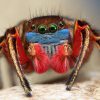I am a sensory ecologist curious about the functional morphology and the evolution of eyes. My interest lies in coming up with ways of describing how eyes and vision have evolved across species. While vision is a ubiquitous biological mechanism, we are still in the dark when it comes to a lot of questions surrounding it. My goal is to develop frameworks to describe and understand macro-scale patterns in eye characteristics and tie these back into the animals’ behavior and ecology.
Understanding these patterns can give us a better sense of the ways in which animals perceive their surroundings and provide us new perspectives into life on earth. I believe that these unique perspectives can open the doors to novel creative solutions and technological advancements. In my off time, you can find me putting together feasts from scratch, immersing myself in interactive digital media, or biking around Cincinnati.
2020-present PhD Student, Biological Sciences, University of Cincinnati
2017-2020 Research Associate, Helen Wills Neuroscience Institute, University of California, Berkeley
2013-2017 BS in Mathematical and Computational Biology, Harvey Mudd College




